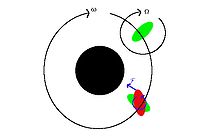Billy, if you had read my post carefully, you would not irritates so easily. I said "I consider that this is ..." I have not said "this means". It was just a subjective opinion! Or should I not own opinions, but instead only approve your "FACTS"? Perhaps a little modesty would not hurt you!
Following your path of thinking, and of course your math, and making a forced statement accordingly,
"I, for certainly affirm that our Moon is not orbiting around the Earth at all! Instead it real orbiting path is around our galactic center, and its tiny oscillatory crossing of the Earth's trajectory around the Sun, and of the Sun trajectory around the galactic center, give only a FALSE impression that the Moon is orbiting the Earth and the Sun!" What do you think about this? It is a normal extrapolation, complying the rules of your way of thinking, and your math. Do you agree with my statement? Or not?
As I already said in a previous message, try to adapt your math to real movement of the Sun-Earth-Moon system, not the real movement of this system to your math. And try to not forget, that image from wikipedia is just a projection on a sheet of paper, a draw which represent the both paths followed by Earth and Moon on their revolution around the Sun, over a period of time. This image do not represent the true motion, but the graphical representation of the vectorial summation of the angular momentum of the Moon and Earth wrt the Sun, over a period of time covering a full revolution of the Moon around the Earth (~27 days).
The real movement of this system can be seen here (real movement wrt the Sun):
- h t t p://phys23p.sl.psu.edu/phys_anim/astro/embederQ4.15100.html
And here can be seen something similar to that image from wikipedia (projection pats wrt the Sun):
- h t t p://phys23p.sl.psu.edu/phys_anim/astro/embederQ4.15200.html
To see these animations you need to have installed the QuickTime player!
Which one do you think that represent the real movement of the Earth-Moon system around the Sun? The first one, or the second one?
Your example with the car around the train is a false example, due to the next:
- both the car an the train are two separate and independently acting objects
- both have their own independent energy of motion (kinetic energy)
- if both object have the same independent velocity (wrt the Sun) they never can cross the path of the other, back and fort (or up and down depending on the reference point of view) - lack of monthly phases
If a train and car were both traveling at 67 mph and periodically the car crossed (using a bridge) to the other side of the train track, {a lateral movement of say 200 feet, using bridges 67 miles apart - one side step every hour} our impression would be that the car is orbiting the train. – That is what the moon does. – It crosses to the other side 26 times each year, giving the FALSE impression that it is orbiting the Earth. Exactly like the car seems to be orbiting the train.
- both the train and the car are moving independently on a straight path, they do not orbit around a center of rotation
Even though the car´s "orbit radius" is ~100 relative times closer to the train´s path than the moon´s 0.25% slight lateral path crossing movement is wrt to distance to the sun, I doubt you would be so SILLY as to describe the car´s movement as orbiting the train. INSTEAD OF say: "The car is traveling along side the train for 67 miles and periodically shifting from being 100 feet on one side to 100 feet away from train on the other side every 67 miles." I.e. the car is much more "tightly bound" to the train than the moon is to the Earth.
No, I am not so SILLY to describe the car movement as orbiting the train. But also, I am not so SILLY to accept your totally false analogy of the train and car movement with the Earth and Moon movement. And one more thing: to make 100 feet on both sides of the train the car must have to accelerate or decelerate, and to change its velocity. And of course it can do this, because it has a movement independent from the train. Do you think the Moon has something similar, or can do something similar?
And wrt to your last message, the apology of the Moon synchronous spin with revolution movements, explain how, in the case when the Moon has its own axial rotation, even a single REAL rotation during a revolution, if I am on the unseen side of the Moon, why I can not still see the Earth?

